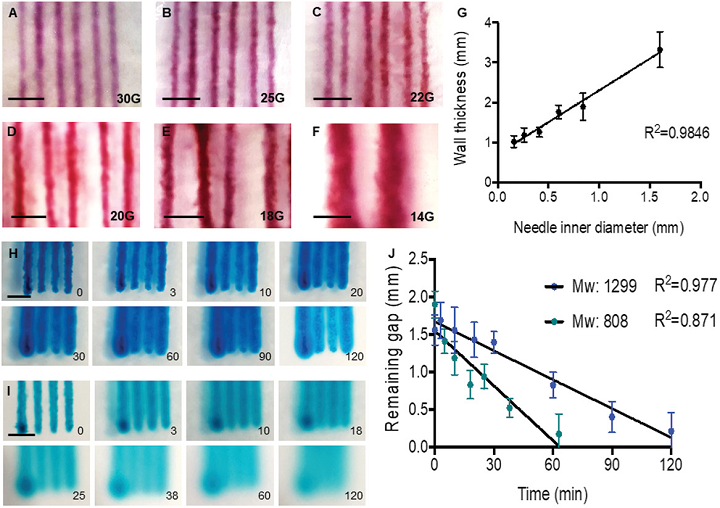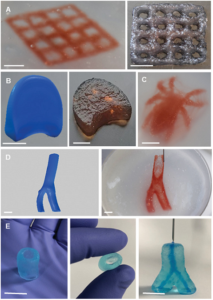FRESH News: SLAM Used to Fabricate Complex Hydrogel Structures With Gradients
There has been plenty of research on creating 3D printed hydrogels and using them to fabricate functional tissues. Biopolymer hydrogels, with properties that can be tailored and controlled, can be crosslinked to replicate tissue structures, and extrusion-based 3D printing is often used. But, the use of biopolymer hydrogels as 3D printing bioinks is tough, due to issues like low viscosity and trouble controlling microstructure variations. Some researchers have turned to embedded 3D printing methods, but this comes with its own laundry list of problems, such as having difficulty extracting the final product.
UK researchers Jessica J. Senior, Megan E. Cooke, Liam M. Grover, and Alan M. Smith from the University of Huddersfield and University of Birmingham created a method called suspended layer additive manufacturing, or SLAM, that can extrude low viscosity biopolymers into a self‐healing fluid‐gel matrix. The team recently published a paper on their work, titled “Fabrication of Complex Hydrogel Structures Using Suspended Layer Additive Manufacturing (SLAM).” It is worthwhile to note here that FRESH (Freeform Reversible Embedding of Suspended Hydrogels) is a super remarkably similar if not identical technology. So far we’re not getting involved with calling out which term should win here but we are leaning towards using FRESH because it will make it simpler for everyone going forward.
The abstract states, “There have been a number of recently reported approaches for the manufacture of complex 3D printed cell‐containing hydrogels. Given the fragility of the parts during manufacturing, the most successful approaches use a supportive particulate gel bed and have enabled the production of complex gel structures previously unattainable using other 3D printing methods. The supporting gel bed provides protection to the fragile printed part during the printing process, preventing the structure from collapsing under its own weight prior to crosslinking. Despite the apparent similarity of the particulate beds, the way the particles are manufactured strongly influences how they interact with one another and the part during fabrication, with implications to the quality of the final product. Recently, the process of suspended layer additive manufacture (SLAM) is demonstrated to create a structure that recapitulated the osteochondral region by printing into an agarose particulate gel. The manufacturing process for this gel (the application of shear during gelation) produced a self‐healing gel with rapid recovery of its elastic properties following disruption.”
SLAM works like this: shear cooling a hot agarose solution throughout the sol–gel transition creates the fluid-gel print bed, as fluid gels behave like liquids once stress is applied. Then, the solution is put into a container in order to support the scaffold. Hydrogel and cells are mixed to produce a bioink, which is added to a bioprinter cartridge and extruded into the self-healing, fluid-gel matrix. The bioink is then suspended in its liquid state, and solidification is induced through crosslinking and cell media, which also provides the cell scaffold with metabolites. The construct is released from the supporting gel through low shear washing with deionized water.
The method prevents the initiation of gelation during 3D printing, which allows for great layer integration and “the production of constructs from two or more different materials that have dissimilar physicochemical and mechanical properties,” which creates a part with anisotropic behavior.
“To demonstrate clinical application, we recently created a structure that recapitulated the osteochondral region (the microstructure of which changes across a hard/soft tissue interface) as directed by microcomputed tomography (micro‐CT) imaging to provide accurate dimensions and was tailored to support specific cell phenotypes by controlling the microenvironment,” the researchers explained. “These complex scaffolds feature mechanical gradients that were similar to those found within the ECM and play a crucial role in preventing mechanical failure between interconnecting tissues as well as maintaining cell phenotype.”
The researchers needed to consider the mechanical properties of the fluid-gel print bed during SLAM 3D printing, as “they can impact on construct resolution and complexity.”
“Another embedded printing technique, freeform reversible embedding of suspended hydrogels (FRESH), developed by Hinton et al., uses a gelatin slurry support bath, however the rheological behavior of such material as a suspending agent for 3D bioprinting has not been investigated in depth,” the researchers wrote.
Additionally, they prepared fluid gels at different concentrations of agarose in order to find the best formulation for 3D printing uniform particle sizes, and investigated using needles with differing inner diameters, and a low viscosity dye solution, to find the optimal print resolution.

Optimizing print parameters within agarose fluid gel. A–G) Resolution of bioink printed within fluid bed support using multiple needle diameters and H–J) diffusion of dye through the gel at given time points.
“As the needle inner diameter was increased, the potential resolution decreased. Further, with larger needles, the printable filament thickness was more variable. This is likely due to both more material being extruded and also greater deformation of the fluid‐gel print bed. In very low viscosity solutions of low Mw (molecular weight), diffusion is also a limiting factor for resolution,” the researchers explained.

A) Intricate lattice prior to (left) and following extraction (right) from the bed. B) T7 intervertebral disc as CAD file (left) and lateral (middle) and apical (right) views. C) Intricate bulk structure in the form of a gellan spider. D) Carotid artery as CAD file (left) and during printing (right). D) Tubular structure (left) demonstrating material durability (middle) and perfusibility.
Alginate, collagen, gellan gum, and i‐carrageenan bioinks were used to demonstrate how many complex structures could be made. An intricate lattice structure showed off the scale and complexity that SLAM can achieve, while a T7 intervertebral disc was manufactured to show how the system can print large bulk structures and a spider was an example of 3D printing smaller, more intricate parts.
Several hollow and bifurcating structures, like a carotid artery model and a thick-walled tubular structure, were printed to show how the system can create geometries which are impossible without a 2D collector.
“These structures highlight the capability of this technique for freeform fabrication as large overhanging structures can be printed without the need for additional support structures,” the researchers explained.
The SLAM method can also deposit multiple layers laterally, horizontally, and within “a previously deposited extrude,” which allows constructs to be fabricated with the same biochemical and mechanical gradients that can be found in native tissues. The technique also uses microextrusion to continuously dispense bioinks, which caused better dispensing precision than the use of inkjet printing, and allows for more freedom with cell densities inside the bioink.
“Previous studies have indicated that the use of inkjet printers enables a reduction in print‐induced shear stresses applied to suspended cell populations compared with microextrusion methods, however, there are key features of the supporting bed utilized for SLAM that enable shear minimization utilizing microextrusion,” the researchers wrote.
Due to SLAM’s supporting fluid‐gel bed, low viscosity bioinks can be used – material viscosity can cause shear induction in bioinks, so it’s optimal for fabricating hydrogels.
“Using our system, it has therefore been demonstrated that the issues associated with cell shearing during microextrusion can be easily reduced, achieving admirably low shear stresses on cells that rival those seen during other forms of biofabrication including drop‐on‐demand techniques such as inkjet printing,” the team wrote.

A,B) Bilayer scaffolds using combinations of collagen‐alginate and collagen‐gellan. C) Large collagen‐core gellan‐shell scaffold and D) small collagen‐core alginate‐shell scaffold. E) Schematic of diagram showing control of cell behavior with attachment motif bearing complexes in the upper collagen gel and no attachment motifs for cell suspension within an alginate gel. F) Micro‐CT showing gradient porosity within a lyophilized collagen‐alginate scaffold. G) Confocal micrographs of Hoechst/actin cell staining of HDFs attached in the collagen layer and suspended in the alginate regions of a dual layer scaffold. H) Stress versus Gʹ showing variations in gel strength and elasticity across a collagen‐alginate scaffold.
The SLAM method can also incorporate multiple biopolymer hydrogels into a single structure, which is important to “satisfy the mechanical, chemical, and biological variations that occur throughout native tissue.” The researchers demonstrated this capability by 3D printing an osteochondral construct, with ex vivo chondrocytes deposited into a gellan gum layer and osteoblasts into one of gellan‐hydroxyapatite. But they went even further, and used SLAM to 3D print integrated structures with different chemistries and gelatin mechanisms.
“Ionotropically gelled (alginate, gellan, and ι‐carrageenan) and thermally gelled (collagen) biopolymers were successfully integrated to form interfacing, dual‐phase scaffolds,” the researchers wrote.
The materials blended enough that mechanical failure did not occur – an environment that closely mimics the native tissue environment.
“Furthermore, this technique of printing integrated layered structures is not only compliant to printing different materials layer upon layer, but also deposition of a second material into the center of another. For example, in addition to producing layered constructs, it was possible to create 3D printed core–shell structures comprising a cylindrical core of collagen encapsulated within a gellan or alginate cylinder with various dimensions,” they continued.
“Another advantage of being able to deposit scaffold material precisely is that cell behavior can be spatially manipulated. Polymers such as collagens that are saturated with integrin binding domains allow cell attachment to the scaffold, whereas alginate and gellan do not naturally possess cell attachment motifs and instead, encapsulate cells with minimum attachment to the surrounding material.”
To learn more about the team’s use of SLAM to 3D print multilayer gradient scaffolds, I suggest you read the paper – they can explain it far better.
“In summary, we have demonstrated that the SLAM technique can be used to overcome the problems associated with using low viscosity bioinks in extrusion‐based bioprinting,” the researchers concluded. “The method enabled the successful fabrication of bulk, intricate, dual phase, and phase‐encapsulated hydrogels from a variety of biopolymer materials that are currently widely investigated in regenerative medicine. Furthermore, it was shown that controlled spatial gradients in mechanical and chemical properties can be produced throughout a single part with interface integrity between different materials. This allows for physicochemical properties of the structure to be designed accordingly with the ability to control porosity, mechanical gradients, cell distribution, and morphology.”
Discuss this and other 3D printing topics at 3DPrintBoard.com or share your thoughts below.
The post FRESH News: SLAM Used to Fabricate Complex Hydrogel Structures With Gradients appeared first on 3DPrint.com | The Voice of 3D Printing / Additive Manufacturing.

